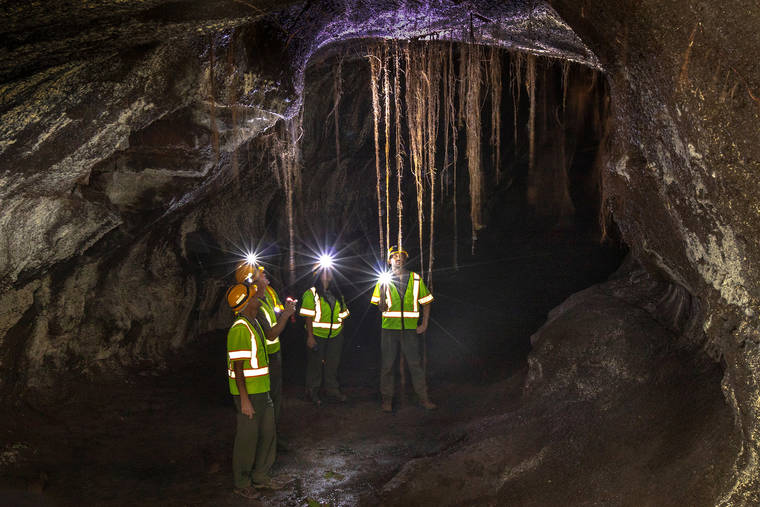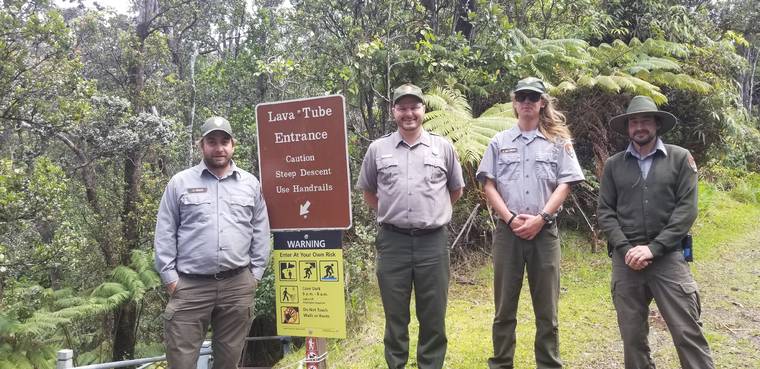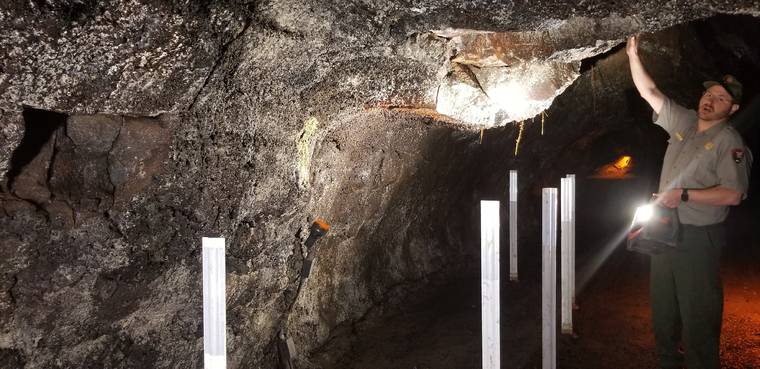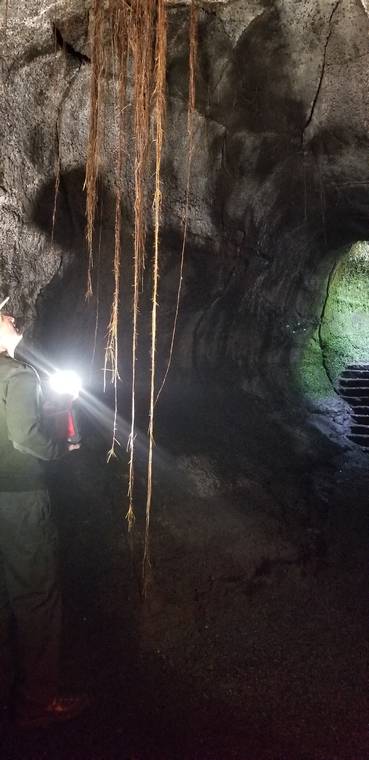HVNP’s Thurston Lava Tube reopens

Rangers examine delicate ohia tree roots in the Thurston Lava Tube. (NPS Photo/J. Wei)

Michael Brestovansky/Tribune-Herald Left to right: Jim Huck, acting road and trails supervisor; Jon Christensen, chief of facilities management; and buildings and utilities workers Dane Van Orman and Brian Agurkis.

Jon Christensen, standing alongside new pylons warning visitors of a low ceiling.

Michael Brestovansky/Tribune-Herald HVNP chief of interpretation Ben Hayes observes ohia roots in the Thurston Lava Tube.
After more than a year of closure, the Thurston Lava Tube in Hawaii Volcanoes National Park is once again open for visitors today.
After more than a year of closure, the Thurston Lava Tube in Hawaii Volcanoes National Park is once again open for visitors today.
One of the three biggest attractions in the park — alongside the already-reopened Visitors Center and the indefinitely shuttered Jaggar Museum — the lava tube, also called Nahuku, has been closed for 658 days, ever since the park shut down in 2018 during the Kilauea eruption.
The road to reopening the tube has been a long one. Jon Christensen, chief of facilities management at HVNP, said the reopening — which officially will happen at 10 a.m. today — is the result of thousands of man-hours, coordination with mainland agencies and about $170,000.
The long delay in reopening the tube is to ensure visitors’ safety, Christensen said. When park staff returned to assess damage caused by the thousands of earthquakes within the park during the eruption, they found evidence of a rockfall within the tube.
“Once we saw that, we knew we had to get an expert analysis of the tube to make sure it was safe,” Christensen said. “For a while, we wouldn’t even let staff work in here.”
Rockfalls are not uncommon inside lava tubes — “gravity is strong in here,” Christensen said — but the last major rockfall in Thurston happened in 1975 when a falling boulder destroyed a footbridge leading into the tube.
“There remain inherent risks to being inside a lava tube,” said Ben Hayes, HVNP’s chief of interpretation. “There are going to be tripping hazards, places to hit your head, and a risk of falling rocks.”
However, Hayes went on, the park worked to mitigate those risks as much as possible, conducting analyses of the tube that included a 3D laser scan of its interior by an engineer from the National Park Service, which was compared to a pre-eruption scan to determine what changes occurred in the interim and whether they threatened visitors’ safety.
The tube’s interior bears signs of these investigations. At several points along the tube’s walls, staff removed rocks that were deemed to be a potential falling hazard, and along two cracks in the tube’s ceiling are a pair of unobtrusive scanning instruments that monitor in real time any infinitesimal movements of the lava rock.
The park also took advantage of the long closure to make some long-requested changes to the tube, including the addition of fine gravel to the cave floors — replacing mud on the ground that occasionally caused visitors to slip — and the addition of several reflective pylons around a low-hanging part of the ceiling, to keep visitors from hitting their heads.
But other changes to the tube are natural.
“The cave environment here is really unique,” Christensen said. “And this has been the longest period the tube has been closed since it was discovered, I think.”
In the absence of humans and light — power to the tube’s interior lights was cut during the closure — growing things in the tube have flourished. ‘Ohia roots dangle like vines from the ceiling all the way to the floor, each sustaining tiny ecosystems of insects, while a white “microbial mass” has spread all across the tube’s walls.
Christensen said the park urges visitors to not touch the roots or the tube walls in order to preserve the natural state of the cave interior for as long as possible.
Before the tube’s closure, ‘ohia roots that grew within arm’s reach were inevitably torn out, while the microbial mass on the walls could never thrive among the thousands of daily visitors brushing against the stone. The stone protuberances that gave the tube its Hawaiian name have long since been destroyed by decades of visitors hungry for souvenirs.
However, the tube always has been an immensely popular feature of the park, attracting the majority of the park’s thousands of daily visitors. That level of traffic has led to notoriously frustrating parking at the tube’s entrance, with dozens of cars jockeying for a limited number of parking spaces as larger vehicles load and unload groups of visitors.
Starting today, a new parking arrangement will begin at the Thurston Lava Tube entrance, with fewer parking spots available — only 14 — but each one limited to a maximum park time of 30 minutes. The new parking stalls are oriented parallel to the road and have dedicated spaces for tour loading and unloading.
Hayes said the new parking plan is still be subject to changes, but will allow visitors to view the tube and leave without backing into open traffic lanes. Because of the limited space and time, that parking area is not ideal for hikers setting out on nearby trails.
“Pack your patience,” Christensen said. “It’s not likely that you’ll find parking here. If you want parking, try to get here before 10 a.m. or after 3 p.m.”
Christensen strongly advised hikers to instead park at the nearby Kilauea Iki parking lot, adding that such a route is faster, safer and more scenic than attempting to park at the tube. That parking lot has 64 stalls and was reconfigured earlier this week to allow easier access.
However, Christensen said the “premier” park trail experience is a seven-mile round trip hike from Devastation Trail, connecting to Kilauea Iki Trail via Byron Ledge Trail to the lava tube.
Even with the tube reopened, there are still sections of trail that remain closed after the eruption. Christensen said one section of Crater Rim Trail by the Kilauea Overlook is expected to reopen in a matter of weeks.
“It’s taken thousands of hours to get this open again,” Christensen said. “Every member of my team has worked incredibly hard to make this happen.”
Email Michael Brestovansky at mbrestovansky@hawaiitribune-herald.com.


